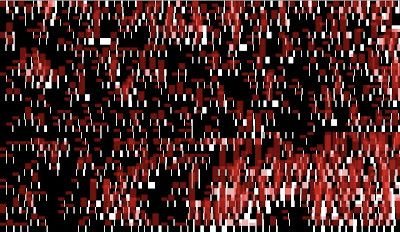



 *** here is a link to run my first demo ... this is just a draft, more to show a concept...a work in progress ***
*** here is a link to run my first demo ... this is just a draft, more to show a concept...a work in progress ***
It is important to remember that at the core of all computational processes is physical matter. Physical matter, a material, like brick, stone, grass or air. Our imprint can and should be seen in this matter. A brick wall as a discrete system, has a tendency towards expressing an inherent state. When another discrete system, such as a person comes into contact with the wall. There are pathways, channels, entry points into the system of the wall. Keys access these. Keys are everywhere…walls can be anything. You need an entry point to change the state of the wall. And depending on the wall’s natural tendency (rigidness….or high probability) towards a certain state can influence our ability to effect the wall. That being said, data stored in databases is the same as the data of walls. It is a new material however, with the ability to mimic, transform, a template to create virtually any system…and apply to it virtually any properties.
This is a really exciting idea for me, what happens when the material of computers, bits, is packaged in ways that it can be extended onto all different properties. Where the interaction between discrete systems, trying to connect becomes the structure of the system itself.
The xicui entertainment center is a building facade with 640x370 square led panels. Each led panel, doubles as a solar panel, with photo-voltaic cells that store energy during the daytime. With no light, the wall has an inherent texture, tendency towards a certain pattern. This pattern is described by 3 different categories of pixels that make up the wall. The darkest panels are the ones with the most photo-voltaic cells (let the least amount of light through. The medium have the middle range of photovoltaic cells, and the brightest have no photo-voltaic cells.
Using data from the density mappings of the 3 ranges, this program cycles through the wall, addressing each pixel, one at a time. For each pixel, the wall as a discrete entity is projecting a state (on/off), the state of the wall is not random, it is influenced by the value from the density mapping, specific to each individual pixel. The state the wall is expressing is pulled towards a value determined by the density map. Analogously, the human has their own control. A single isolated entry point, counterpoint, where a vocabulary is shared with the facade. Like the wall, the human can project a state, using the same on/off language. The human and the wall are analogously addressing the same point on the wall. Ultimately, the human has the final say on what value the current pixel will display, but if the wall is in disagreement with the human(determined by probabilities derived from density maps), this will be shown with a red line appearing perpendicular to the current pixel. The size of the line is proportional to the interaction, communication between human and wall at that discrete entry point in time/space.
The effect is one where I hope to create a new wall whose structure is described by the interaction between the human and the natural state of the walls material. A push, pull between both forces...where both discrete bodies are represented, cycle into and form an inherently transformative system.
I have been working on developing a software model in order to study innovation from this theoretical and practical perspective. I am doing, pretty much all of my design projects as iterations of this, because this is how I think we should be designing things. Data is a huge subject, what to do with it, how to clean it up is an important problem and question. I think we should be designing with this in mind. Where the things that we design are specifically to channel, and transform data. Built in sensors (entry points)....which in itself is a transformation between spaces(when you choose entry points, data is lost...), and algorithms on top of this to compute and determine how this data is used, and is recycled back into the system.
20080214
xicui entertainment center - content prototype 1
Subscribe to:
Post Comments (Atom)


1 comment:
This is an intriguing idea. I am not sure, but intuitively I think this approach could be very useful in understanding how genomes drive differentiated protein behavior. Have you thought about applying this complex database idea to human biology?
Post a Comment